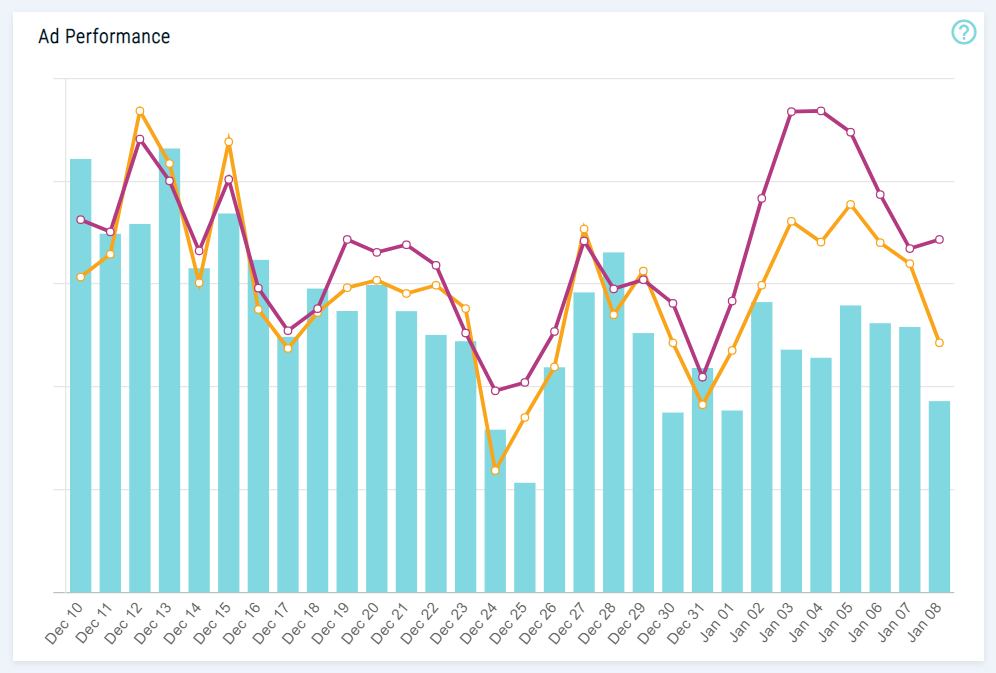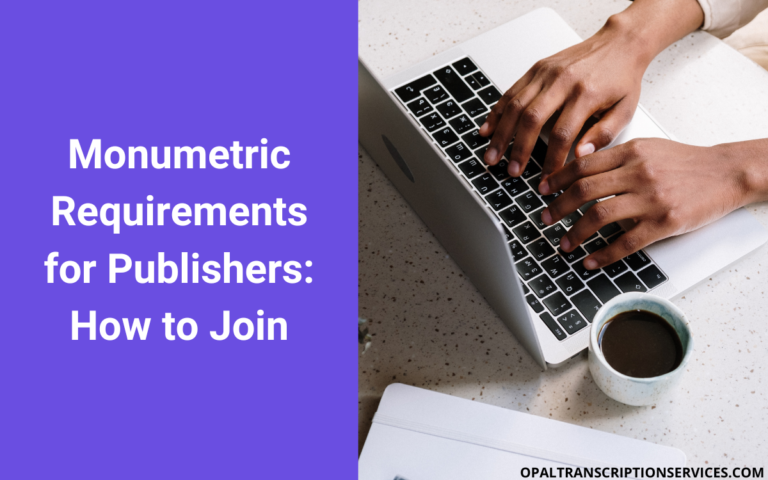Monumetric Review: How I Boosted My Blogging Revenue and RPM
If you’re looking for a premium ad network with high RPMs, fast-loading ads, easy setup, great support, and low minimum pageview requirements, Monumetric should be among your top considerations. In this Monumetric review, I’ll share my personal experience with the platform after my first few months of moving over from Google AdSense.
Also, if you’re wondering how to make the switch to this high-performance display ad network, be sure to check out my post on Monumetric requirements for publishers, where I discuss the application and onboarding process in greater detail.
What is Monumetric and how does it work?

Monumetric is a premium ad network that was founded in 2012 under the name The Blogger Network. They later rebranded to Monumetric to be inclusive of content publishers more broadly (including business sites like this one, for example).
As a premium ad network, Monumetric partners with advertisers who are willing to pay top dollar for ad impressions (instead of clicks, as with AdSense) on sites with quality content and engaged visitors.
For smaller but growing publishers, Monumetric offers a higher-paying alternative to an entry-level ad network like Google AdSense, and a great way to monetize your website and supplement passive income from other blogging channels like affiliate marketing.
They’re also an excellent alternative to premium networks like Mediavine and AdThrive that have high minimum traffic requirements.
Monumetric is often compared to Ezoic in terms of expected earnings and RPM, but with simple done-for-you integration and few, if any, complaints about ads significantly impacting site speed – so, a great Ezoic alternative as well.
The ad platform’s industry-leading technology is designed to maximize your revenue with minimal impact to site speed. They offer a wide variety of ad unit types and dimensions for desktop and mobile – for example:
- Leaderboard
- In-content
- In-image
- In-screen (sticks to bottom of browser and “floats” as user scrolls)
- Sidebar
- Pillar
- Interstitial (full-screen ads that display between certain user actions)
- Video
- Sticky
- Flex
As a full-service ad platform, Monumetric handles everything for you from start to finish, including:
- Matching your site with top-paying advertisers and working with them to get your site approved
- Designing, building, and optimizing your custom ad strategy
- Installing ad tags on your site
- Managing advertiser bids
- Reporting on important metrics such as earnings, pageview and session RPM, ads per session, and more
- Handling collections from advertisers so you get paid monthly
My results with Monumetric so far (a quick case study)

Before signing on with Monumetric, I was monetizing this site with Google AdSense. My RPMs with Google AdSense were apparently quite high compared to many blogs in my niche. This is probably partially because I write very long-form articles (2000+ words).
My average Page RPM for my final 12 months with AdSense was $9.58 in Canadian dollars, which works out to approximately $7.06 USD at the current exchange rate.
For context, my blog could broadly be described as business and technology related. My site is also a service business website, which disqualifies my site from certain other ad networks. This fact, combined with the high RPMs I’d heard about from other bloggers using Monumetric, made this ad platform a natural next step for taking my blogging income to the next level.
Since working with Monumetric for the past few months, my average Pageview RPM is currently $16.54 USD, with an average Session RPM of $18.17 USD.

As you can see, my ad revenues have more than doubled since making the switch.
However, it’s still early in the game and there are a couple of important factors which could influence this data: In the averages calculated above, I included my RPMs during Monumetric’s initial “ramp-up” period of about 30 days, when advertisers are “acclimating to your site and determining their spend,” as a Monumetric team member explained in an email to me.
I hoped that by including this period of lower RPMs, I could offset some the recent higher RPMs due to signing on with Monumetric near the start of Q4. Companies increase their ad spend during the holiday season, so it’ll be interesting to see how everything averages out after I collect a few more months of data.
I’m also planning to make a few changes to my theme to maximize RPM. Updates to follow. 😊
Monumetric RPM and earnings: How much can you make?
I’ve heard of bloggers quoting numbers like four, six, and 10 times the revenue when switching from AdSense to Monumetric. As noted above, in my case, ad revenues didn’t jump that much. But I had high AdSense RPMs to begin with and they more than doubled, so I’m not complaining!
So what could your site earn? Because there are so many factors that go into RPM, it’s impossible to predict with any accuracy how any site will perform when switching to a new ad network. Some of these factors include:
- Your blog category, industry, or niche
- Quality and length of content
- Site design and content layout (font size, paragraph length, etc.)
- Number, size, type, and placement of ad units you display on your site
- Visitor demographics
- Visitor engagement
- Advertisers that display ads on your site and how relevant they are to your audience
All of this means that two blogs in the same niche can get very different average RPMs, which is why you have bloggers reporting notable variations in their Monumetric earnings.
That said, I know you’re here for the numbers, so I’ve done the math on four hypothetical blogs, shown below. The average RPMs for these blogs range from $5-$20, which is the typical range for most publishers using Monumetric. (As noted above, my average Pageview RPM is $16.54.)
RPM is the metric that bloggers use most often for evaluating their current ad strategy. It stands for “revenue per thousand impressions” and is calculated using the following equation:
RPM = Revenue / (Pageviews/1000)
If we plug in some numbers for pageviews and RPM, we can use this equation to calculate earnings for our imaginary blog. So, for a blog with 10,000 monthly pageviews:
| Pageview RPM | Revenue |
| $5 | $50 |
| $10 | $100 |
| $15 | $150 |
| $20 | $200 |
For a blog with 25,000 monthly pageviews:
| Pageview RPM | Revenue |
| $5 | $125 |
| $10 | $250 |
| $15 | $375 |
| $20 | $500 |
For a blog with 50,000 monthly pageviews:
| Pageview RPM | Revenue |
| $5 | $250 |
| $10 | $500 |
| $15 | $750 |
| $20 | $1000 |
And, finally, for a blog with 100,000 monthly pageviews:
| Pageview RPM | Revenue |
| $5 | $500 |
| $10 | $1000 |
| $15 | $1500 |
| $20 | $2000 |
Hopefully the numbers above give you a sense of what you might be able to achieve with your own blog.
Note that RPM is just one metric that Monumetric uses for gauging your ad performance. Others include CPM, eCPM, eCPC, and Ads Per Pageview.
Pros and cons of Monumetric for publishers
Any ad network you choose is going to have pros and cons, and so it is with this one. Let’s start with the pros.
You’ll make more money. This is a no-brainer. If you’re changing from Google AdSense to Monumetric, you should see higher RPMs and a notable boost in revenue. This is because, as a premium ad network, Monumetric works with premium advertisers to help you earn the most money possible for your ad space.
They’re also a great alternative if you’re making the switch from another premium ad management network: Monumetric takes just 15-30% commission for servicing your ads. This is a lot lower than the industry standard, which is 40-60%. This puts more of your hard-earned money back in your pocket.
Setup is easy, even for non-tech-savvy people. Some ad platforms leave implementation entirely up to you – and if you mess up, it can negatively impact your site speed and user experience.
With Monumetric, you don’t have to mess around with any code. The team will build and install your ad tags for you. And if at any time you decide to make changes to your strategy, you can get in touch with support and they’ll implement the requested changes in a reasonably short period of time.
PayPal fees are covered. If you don’t have a US-based bank account for direct deposits, you’ll need a PayPal account to receive your payments. PayPal normally charges a fee to the recipient of the funds, which can be close to 4% on transactions outside the US.
So as an example, if you receive a payment of $489.13 USD, PayPal can take a whopping $18.40 USD (true story). These fees add up quickly.
As a non-US based publisher with Monumetric, you don’t need to worry about losing money to PayPal, as your fees are covered.
Support is responsive and friendly. In my experience, the support team usually answers within a few minutes to a few hours. As a publisher, you’re encouraged to communicate any questions or concerns you have, and you can always get in touch to request changes to your ad strategy.
There are a few different ways you can get help when you need it. If you can’t get a quick answer by searching the help base in your publisher dashboard, you can message support directly from the dashboard or send them an email. You can also reach the company via the phone number on the website.
You’re not locked into a long-term contract. As a publisher, it’s important to have the freedom to test different monetization options so you can give your blog or website the best chance of success. And sometimes, making the right decision for your business means moving on from a partnership that was once a great fit.
Some premium ad networks have an initial lock-in period of, for example, 90 days. With others, if you fail to read the fine print, you’ll find yourself locked into a contract of a year or more – and if you cancel early, they’ll dock your pay.
If you choose to end your contract with Monumetric, they only require that you give them 30 days’ notice.
Monumetric is open to a wider variety of publishers. Some premium ad networks have restrictions about the types of sites or niches they’ll accept as publishers. For instance, they might not accept business websites that offer products and services, or they’ll only accept blogs within the lifestyle, food, or mommy blog niches.
And, of course, some networks require you to have minimum monthly traffic of 50,000-80,000 – in sessions, not pageviews – just to come on board.
As long as you have content to monetize and just 10,000 monthly pageviews, you can apply as a publisher with Monumetric.
Now on to the cons. If you’re moving to a premium ad management platform from Google AdSense, you should brace yourself for some minor inconveniences. For instance:
The application and setup process can take a few weeks. After the team has verified that you meet minimum traffic requirements, there’s still quite a bit of email back-and-forth. There’s also a delay of up to a few weeks while you wait for enough of their ad partners to approve your site.
For my site, the whole process took three and a half weeks from the day I filled out the online application to the time the ads were live on my site.
On the bright side, all the steps were super easy and I didn’t have to do any of the actual implementation.
There is a one-time $99 implementation fee. This fee only applies to publishers signing up for the Propel program, which requires a minimum of 10,000 monthly pageviews. Even if you’re barely generating this minimum traffic amount, you’ll make your money back quickly.
There’s a reporting delay. If you’re switching to Monumetric from AdSense, you’ll be used to what feels almost like real-time reporting, with impression and click data that updates every 15-30 minutes.
In contrast, the data in your Monumetric publisher dashboard can take a day or two to update. If you’re a new blogger, this can be a bit of an adjustment, as it’s tempting to continually check your earnings. For experienced bloggers, it likely won’t matter as much.
Payments are net-60. Unlike AdSense, which pays every 30 days between the 21st and 26th of the month, Monumetric pays on net-60 terms on or before the 15th day of each month. The net-60 period begins at the end of each month.
There’s also a processing period of 10 business days – meaning that in the month your payment comes due, you’ll be paid within the first 10 days of the month. This waiting period is because advertisers have a processing period of their own.
However, I don’t consider this a major con because, once you get your first payment, money is coming in every month (from the month two pay periods ago).
Monumetric vs. Adsense
All things considered, switching to Monumetric from AdSense has definitely been worth it for my blogging business. If you’re considering making the switch, the main differences to be aware of between the two platforms are:
- Earnings: Higher RPMs and revenue with Monumetric (you can find bloggers reporting anywhere from a 2-10X increase); in addition, your earnings will fluctuate a lot less with Monumetric because they pay per impression rather than per click
- Payment terms: AdSense is net-30, while Monumetric is net-60
- Payment method: AdSense pays via direct deposit or wire transfer, while Monumetric pays via direct deposit for US-based publishers or PayPal for non-US-based publishers (fees are covered)
- Onboarding: AdSense is free to join and takes anywhere from a few days to four weeks to get approved; Monumetric has a $99 implementation fee and can take a few weeks to get approved and set up (it took me three and a half weeks total)
- Support: Monumetric has an awesome support team, whereas trying to get tech support from Google for anything can feel like screaming into the void
Final thoughts
In this Monumetric review, we covered what Monumetric is, my personal results after using them after a few months, how much you can expect to earn with your own blog, pros and cons of the ad platform, and how it compares to AdSense. If you’re unsatisfied with your AdSense earnings, hopefully this article will inspire you to take the next step in your blogging journey, sign up for Monumetric, and make that coin!






